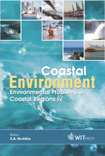Estimation Of Current Driving Force In Suo Sea, The Seto Inland Sea, Japan
Price
Free (open access)
Transaction
Volume
58
Pages
Published
2002
Size
620 kb
Paper DOI
10.2495/CENV020111
Copyright
WIT Press
Author(s)
K Komai & T Hibino
Abstract
The characteristic of seawater exchange in the Suo Sea was investigated from observation results. The seawater exchange in the Suo Sea is strongly influenced by the river discharge and the intrusion of open seawater through the Bungo Channel. The seawater exchange around the Suo Sea is influenced by the annual cycle of the current field in overall the Seto Inland Sea. The close relationship among the annual cycle of sea level height (SLH) in the Set0 Inland Sea, SLP and density was indicated from observation results. Based on the results, in order to estimate the annual cycle of current field in the Inland Sea, the two-dimensional numerical model reflected the annual cycle of density and sea level pressure (SLP) distributions and SLH at the boundaries facing the Pacific as the driving force was developed. The importance of the seasonal current driving force to the seawater exchange around the Suo Sea was indicated by two-dimensional numerical simulation. 1 Introduction The Seto Inland Sea with the surface area of about 22,000 km2, the mean depth of about 37m connects with open sea (the Pacific or Japan Sea) through Kii Channel, Bungo Channel and Kanmon Strait, and there are several regions separated by straits and 23 first-grade rivers (first-grade rivers are under the supervision of the Minister of Land, Infrastructure and Transport). The normal amount of evaporation on the Inland Sea is about l,500mm/year (Ishizaki and Saito, 1978), and the amount of precipitation on the Inland Sea is about 1,40Omm/year (Yanagi, 1997 [l]). According to them, the water budget on the sea surface is estimated about plus 100mm/year. The total river discharge of first-grade river is about 2.9x1010m3/year which corresponds to one thirtieth of the volume of the Inland Sea (8.0x1011m3). The regions have different topographic features and the
Keywords





